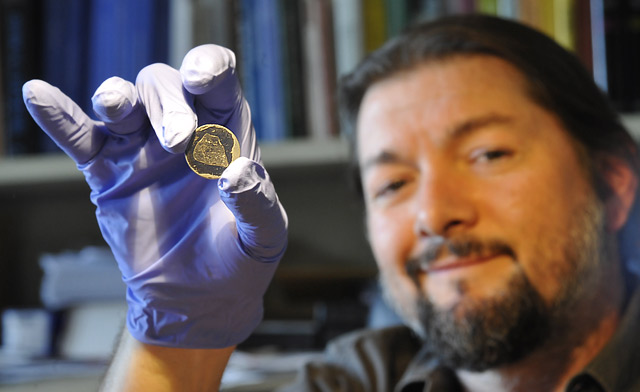Greenwood Finds Water in Moon Rocks

- Jim Greenwood, research assistant professor of earth and environmental sciences, holds a slide with a moon rock sample that contains water. The water was found in the mineral apatite, which he and his team were able to identify in the sample. (Photo by Olivia Bartlett Drake)
Soon after the Apollo spaceflights to the moon, experts examined the rocks brought back by the astronauts and declared with certainty that the moon was a dry, waterless place.
Forty years later, James Greenwood begs to differ. Not only does he have proof, his findings strongly suggest that some of the lunar water he found is not indigenous to the moon or earth but appears to have originated from somewhere else in space.
Greenwood, research associate professor, visiting assistant professor, Earth and Environmental Sciences, pioneered a new method of analyzing the rocks using a combination of light, electron and ion-beam microscopes. He and his international team of planetary geologists and geochemists, announced their findings at the 41st Annual Lunar and Planetary Science Conference in Houston, Texas, in March.
It was a discovery almost didn’t happen, however. In fact, the only reason Greenwood found proof of water on the moon was because he was looking at a rock from Mars.
“I was in a lab at Hokkaido University in Sapporo, Japan, using an ion microscope to measure water in Martian meteorites,” Greenwood, who is a planetary geochemist, says. “We had pioneered this new technique to use two-dimensional ion imaging and were looking at this mineral in the meteorites called ‘apatite,’ which is a common phosphate mineral and holds water. Our analyses had been very good, probably better than ever before. So I thought, ‘What if we used this technique on moon rocks?’”
[youtube]http://www.youtube.com/watch?v=jDJG5wE1UZ0[/youtube]
Greenwood thought of moon rocks because a 2008 study from Brown University had found possible evidence of water in volcanic moon rocks. However, the study had been problematic and its results disputed. Still, Greenwood was intrigued that the possibility of water in the lunar rock samples had not been thoroughly vetted.
“The rocks were all declared devoid of water when they were first analyzed 40 years ago,” he said. “But I thought our new technique held some promise.”
Greenwood’s technique and the advanced instruments he gained access to, made it possible for him and the other scientists on his team to analyze the sample’s chemical composition over areas as small as 5 x 5 microns.
“In the past, they had actually ground up the analyzed samples. This created conditions that put the chemical analysis out of context,” he says. “Our method let us look at the samples as they are, in situ.”
The hardest part was getting permission to examine a sample. Less than 900 rocks were brought back from all the Apollo missions combined. Access is strictly limited.
It took several months, but Greenwood was able to get a few samples to analyze. The first were from the lunar highlands, which he thought might hold promise. But no water-holding apatite was found. Then he gained access to a sliver of rock brought back from the southwestern edge of the Mare Tranquillitatis – the “Sea of Tranquility” – where Apollo 11 had set down in 1969.
“So there we were in the lab at about 3 a.m. and the first sample we looked at, boom, there it was. Water. At first we couldn’t believe it. But we double-checked and we were just blown away. It was clearly there.”
The apatite, which is the same mineral that teeth are made of, was rife with water molecules. However, as Greenwood and his colleagues continued to analyze the samples they found that the water contained in the rocks was not from the earth or the moon.
“It was consistent in the water that comes from comets,” Greenwood says.
How could he tell? Water molecules found on earth – and those indigenous to the moon, since it was once part of the earth – contain a specific ratio of hydrogen to deuterium, which scientists use as a standard. The water Greenwood has found in some of the lunar samples has nearly twice the deuterium.
“The only things that falls into this range with any consistency are comets,” Greenwood says.
He adds that comets have long been known to hold frozen water and that perhaps as much as 10% of the earth’s water had come from comets, as well.
Microscopic water in minerals inside moon rocks is a tremendous find, but in a practical sense it does not open the door to, say, astronauts extracting this water to use on a lunar base or colony. Greenwood says that process would be too expensive and energy-exclusive with current methods. However, his discovery does open up another possibility.
“The level of water we found in the samples are consistent with the amount of water one would find from the mantle in the earth,” he says. “So there may be a reservoir of water within the mantle of the moon. Somewhat like groundwater here on earth.”
How far within the mantle, how deep below the surface is another challenge for another completely different type of study.
But Greenwood and his team have confirmed what many people have wondered for centuries, perhaps millennia. There is water on the moon.

